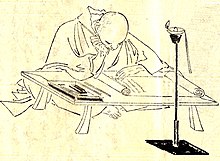Yoshida Kenko

Yoshida Kenkō ( Japanese 吉田 兼 好 ), whose real name was Urabe no Kaneyoshi ( 卜 部 兼 好 ) (* around 1283, probably in Kyoto ; † around 1350 , probably in the province of Iga , today's Mie prefecture ), was a Japanese courtier , poet and buddhist monk .
Life
Urabe no Kaneyoshi is described as a descendant of the Vice Minister of the Ministry of Civil Administration , Urabe no Kaneaki ( 卜 部 兼 顕 ) from Kyoto. Kaneyoshi was initially vice-commander of the palace guard on the left ( 左 兵衛 佐 , sahyōe no suke ), but after the death of the ruler Go-Uda around 1324 he gave up his life at the imperial court of Kyoto to become a Buddhist priest of the Tendai sect and under the new name Yoshida Kenkō to lead a life as a monk, but not in too much seclusion. He remained connected to everyday life and poetry and his poetic work even found its way into an official imperial poetry anthology .
Tsurezuregusa
His best-known work today is the prose collection Tsurezuregusa ( 徒然 草 ; to German "Reflections from the Silence"), which was created around 1334-1339 and published around 1352 posthumously . It belonged to the indispensable educational assets of many generations of Japanese as well as a classic of Japanese literature . It was also considered a prime example of the Zuihitsu genre (i.e. miscell literature , essays ) popular in Japan . The 243 sections follow the aesthetic concept of wabi-sabi , the incomplete, imperfect, improvised and the fleeting, inconstant. Kenkō's prose is also characterized by melancholy , individualism and a longing for the past - also typical of the genre . The spread of the Tsurezuregusa to the public increased, especially in the late 16th century with the print versions .
Famous quotes
- “Wouldn't one shrink like the dew on the Adashi field and not fade away like the smoke on the Toribe mountain, but live forever - how could one grasp the magical melancholy that weaves in all things? It is precisely their instability that makes the world so beautiful. "
- "Nothing gives greater comfort than sitting alone, in silence, in the lamplight in front of a book and in this way making friends with people from bygone days."
- "How painful it is for me to think that all the things that are around you all the time outlast you, as if nothing had happened."
- "Adolescence is the time in which one ruins oneself ... Age surpasses adolescence in wisdom, but adolescence exceeds old age in grace."
- “You should never pretend to have delved deep into an art or science. Will an educated man, even if he has mastered a thing, speak of it with a connoisseur air? It is always only the people from the provinces who answer you as if they had grasped everything deeply ... "
- “The moon on the autumn nights is incomparably beautiful. How poor is a person who knows no differences and believes that this star is the same in all seasons! "
Assessments of himself
- “... a worldly experienced gentleman with a keen sense for what is beautiful in this world of change and with a deep longing for the golden times of court life during the Heian period . His mood pictures are well worth reading as what they are known to this day in Japan: as expressions of good taste. His religious views, on the other hand, are less exciting, since he did not press for answers to the problems of our existence . ”RHP Mason. JG Caiger: A History of Japan . P. 159.
- "Yoshida Kenkō [...] [...] spiritually close to the court aristocracy, observes the reality of society in his essayistic work Tsurezuregusa , in which, as a human being, he also affirms the striving for the material and analyzes the circumstances and the course of time, but without being able to hide his longing for the culture of the declining nobility. Kenkō also seems to have been familiar with the life of the samurai . ” Kiyoshi Inoue : History of Japan . P. 170.
literature
- Wolfram Naumann: Yoshida Kenko (= Kindlers Neues Literatur Lexikon (KNLL) , Volume 17). Carl Hanser Verlag, Munich 1992. pp. 949-950.
- Linda H. Chance: Formless in Form: Kenko, Tsurezuregusa, and the Rhetoric of Japanese Fragmentary Prose . Stanford: Stanford University Press 1997.
- Donald Keene : Essays in Idleness: The Tsurezuregusa of Kenko . Columbia University Press 1998, ISBN 0-231-11255-6
- Kiyoshi Inoue (Author), Manfred Hubricht (Translator): History of Japan . Campus Verlag, Frankfurt / New York 2002 (3rd new edition), ISBN 3880599947 .
- Renato de Guzman-Rosales: World Literature . Goodwill Trading Co., Manila 2010, ISBN 978-971-574-160-6 . Pp. 110-117.
Web links
- Essays by Yoshida Kenko - English
- Translated excerpts from various classical works, including the Tsurezuregusa - German
Individual evidence
| personal data | |
|---|---|
| SURNAME | Yoshida Kenko |
| ALTERNATIVE NAMES | 吉田 兼 好 (Japanese); Urabe no Kaneyoshi (real name); 卜 部 兼 好 (real name, Japanese) |
| BRIEF DESCRIPTION | Japanese author and Buddhist monk |
| DATE OF BIRTH | around 1283 |
| DATE OF DEATH | 1350 |